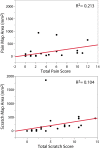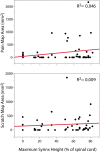Questionnaire-based Analysis of Owner-reported Scratching and Pain Signs in Cavalier King Charles Spaniels Screened for Chiari-like Malformation and Syringomyelia
- PMID: 29105875
- PMCID: PMC5787193
- DOI: 10.1111/jvim.14856
Questionnaire-based Analysis of Owner-reported Scratching and Pain Signs in Cavalier King Charles Spaniels Screened for Chiari-like Malformation and Syringomyelia
Abstract
Background: Chiari-like malformation (CM) and syringomyelia (SM) cause a pain syndrome in Cavalier King Charles spaniels (CKCS). Clinical signs are not consistently apparent on neurologic examination, and owner reporting of signs provides vital clinical history. However, owner questionnaires for this disease are not well developed.
Objectives: To develop a tool to capture owner-reported clinical signs for use in clinical trials and to compare owner-reported signs with the presence of pain on neurologic examination and SM on magnetic resonance imaging (MRI).
Animals: Fifty client-owned CKCS.
Methods: Owners completed a questionnaire and pain/scratch map. Each dog underwent a neurologic examination and craniocervical magnetic resonance imaging (MRI). Questionnaire responses were developed into scores, area of shading for pain/scratch maps was measured, and consistency of responses between these tools was assessed. Owner-reported findings were compared with neurologic examination findings and presence and severity of SM on MRI.
Results: Thirty-three dogs were symptomatic and 17 asymptomatic; 30 had SM. The most common sign of pain was crying out when lifted (n = 11). Extent of shaded areas on maps positively correlated with questionnaire scores for pain (r2 = 0.213, P = 0.006) and scratch (r2 = 0.104, P = 0.089). Owner-reported findings were not significantly associated with presence or severity of SM or neurologic examination findings. Owner-reported lateralization of signs was significantly associated with SM lateralization (P < 0.0001).
Conclusions: The questionnaire and maps may be useful for clinical trials. Lack of association of owner-reported signs with SM highlights our lack of understanding of the pathophysiology of pain in this disease.
Keywords: Neuropathic pain; Paresthesia; Phantom scratch; Syrinx.
Copyright © 2017 The Authors. Journal of Veterinary Internal Medicine published by Wiley Periodicals, Inc., on behalf of the American College of Veterinary Internal Medicine.
Conflict of interest statement
Dr. Olby was invited to give a presentation on proposed work at the Cavalier King Charles Spaniel Club of America in 2015. Her accommodation and travel costs were covered by the group.
Figures




Similar articles
-
Clinical predictors of syringomyelia in Cavalier King Charles Spaniels with chiari-like malformation based on owners' observations.Acta Vet Scand. 2024 Feb 8;66(1):5. doi: 10.1186/s13028-024-00725-1. Acta Vet Scand. 2024. PMID: 38331821 Free PMC article.
-
Investigation of sensory thresholds in Cavalier King Charles Spaniels with and without Chiari-like malformations and syringomyelia.J Vet Intern Med. 2018 Nov;32(6):2021-2028. doi: 10.1111/jvim.15297. Epub 2018 Oct 11. J Vet Intern Med. 2018. PMID: 30307645 Free PMC article.
-
Behavioral and clinical signs of Chiari-like malformation-associated pain and syringomyelia in Cavalier King Charles spaniels.J Vet Intern Med. 2019 Sep;33(5):2138-2150. doi: 10.1111/jvim.15552. Epub 2019 Jul 9. J Vet Intern Med. 2019. PMID: 31290195 Free PMC article.
-
Understanding and Treating Chiari-like Malformation and Syringomyelia in Dogs.Top Companion Anim Med. 2018 Mar;33(1):1-11. doi: 10.1053/j.tcam.2018.03.002. Epub 2018 Mar 15. Top Companion Anim Med. 2018. PMID: 29793722 Review.
-
An update on the pathogenesis of syringomyelia secondary to Chiari-like malformations in dogs.Vet J. 2013 Dec;198(3):551-9. doi: 10.1016/j.tvjl.2013.07.014. Epub 2013 Aug 12. Vet J. 2013. PMID: 23938004 Review.
Cited by
-
Association between filum terminale internum length and pain in Cavalier King Charles spaniels with and without syringomyelia.J Vet Intern Med. 2021 Jan;35(1):363-371. doi: 10.1111/jvim.16023. Epub 2021 Jan 11. J Vet Intern Med. 2021. PMID: 33426675 Free PMC article.
-
Clinical predictors of syringomyelia in Cavalier King Charles Spaniels with chiari-like malformation based on owners' observations.Acta Vet Scand. 2024 Feb 8;66(1):5. doi: 10.1186/s13028-024-00725-1. Acta Vet Scand. 2024. PMID: 38331821 Free PMC article.
-
The beneficial role of companion animals in translational pain research.Front Pain Res (Lausanne). 2022 Sep 5;3:1002204. doi: 10.3389/fpain.2022.1002204. eCollection 2022. Front Pain Res (Lausanne). 2022. PMID: 36133153 Free PMC article. Review.
-
Investigation of sensory thresholds in Cavalier King Charles Spaniels with and without Chiari-like malformations and syringomyelia.J Vet Intern Med. 2018 Nov;32(6):2021-2028. doi: 10.1111/jvim.15297. Epub 2018 Oct 11. J Vet Intern Med. 2018. PMID: 30307645 Free PMC article.
-
CT- and MRI-based volumetry for Chiari-like malformation and syringomyelia in Pomeranians.Front Vet Sci. 2025 Feb 26;12:1549205. doi: 10.3389/fvets.2025.1549205. eCollection 2025. Front Vet Sci. 2025. PMID: 40078213 Free PMC article.
References
-
- Cerda‐Gonzalez S, Olby NJ, McCullough S, et al. Morphology of the caudal fossa in Cavalier King Charles Spaniels. Vet Radiol Ultrasound 2009;50:37–46. - PubMed
-
- Parker JE, Knowler SP, Rusbridge C, et al. Prevalence of asymptomatic syringomyelia in Cavalier King Charles Spaniels. Vet Rec 2011;168:667. - PubMed
-
- Rusbridge C, Knowler SP. Inheritance of occipital bone hypoplasia (Chiari Type I malformation) in Cavalier King Charles Spaniels. J Vet Intern Med 2004;18:673–678. - PubMed
MeSH terms
Grants and funding
LinkOut - more resources
Full Text Sources
Other Literature Sources
Medical

